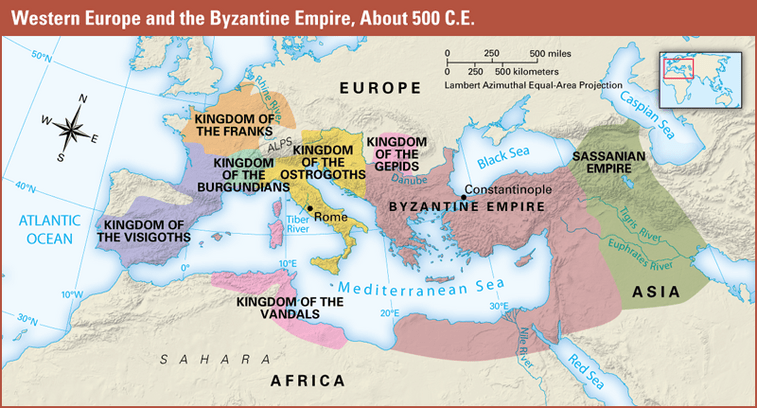Why was the Roman Empire hard to defend?
Because of its massive size, Rome's long border was hard to defend.
What kind of art did Romans wear as jewelry?
Cameo
The Pantheon, a magnificent temple, now a __________ that still stands in Rome, is famous for its huge dome.
church
A Stoic would say this quality—meaning self-respect and honor—is the most important to uphold in life.
Dignity
The Roman numeral I means 1, V means 5, and X means 10. What is this number? XVII
17
In the time period covered by this map, the Germanic tribe that ruled the Italian peninsula was the... 
Ostrogoths
What was the name of the cultural flowering in Europe based on Greek and Roman ideas?
Renaissance
How were the Romans able to build bigger arches than anyone before them?
By mixing stone and sand with cement to make concrete
These two foundational U.S. documents were influenced by Roman ideas about law and government.
The U.S. Declaration of Independence and the U.S. Constitution.
The word vandalism comes from the Vandals, a Germanic tribe whose raids involved destruction of property. By 500 C.E., the Vandals ruled islands and territory in another continent. In what sea were the islands they ruled? On what continent was the territory they controlled? 
Mediterranean Sea; Africa
What are the three weaknesses that led to the fall of Rome?
(100 for each correct answer)
Political Instability - The Romans never developed a good way to transfer ruling power.
Weakening Frontiers - The vast size of the empire made it hard to defend.
Economic and Social Issues - Heavy taxes were needed to support the empire’s large armies, which hurt the economy and pushed many citizens into poverty. This made trade and daily life more difficult for ordinary Romans.
Which modern languages developed from Latin?
(100 for each correct answer)
Italian, Spanish, and French
These three engineering achievements helped with transportation and were considered some of the greatest in the ancient world. What were they?
(100 for each correct answer)
Rome's roads, bridges, and aqueducts
This Roman emperor and Stoic philosopher wrote Meditations, a book still read by millions today.
Marcus Aurelius
 Only one of the Germanic tribes established a kingdom that grew and survived into modern times, as the nation called France. Its name reflects its origins. In 500 C.E. it was the Kingdom of the...
Only one of the Germanic tribes established a kingdom that grew and survived into modern times, as the nation called France. Its name reflects its origins. In 500 C.E. it was the Kingdom of the...
Franks
What happened in 476 C.E., often considered to mark the fall of Rome?
The last emperor (Romulus Augustus) in Rome was removed.
The ceiling of the Sistine Chapel, painted by ____________ in the 1500s, is a famous example of a Renaissance fresco inspired by Roman art.
Michelangelo
Modern buildings still rely on these two key architectural innovations that the Romans perfected.
(200 for each correct answer)
Concrete and arches
What was a major factor in the development of Roman law?
The need to govern a vast empire.
Emperor Constantine named his capital city after himself. By 500 C.E. it was the capital city of the..
Byzantine Empire
What became of the eastern empire after 476 C.E.?
It lasted another thousand years and was called the Byzantine Empire.
How did patrons support the arts?
They paid the artists.
Modern city planning still uses these Roman engineering innovations that brought clean water in and waste out.
efficient sewage and water systems (aqueducts)
This Roman ideal, based on natural law, said that every person is born with these and they cannot be taken away.
Rights - All people have rights.
Below are several areas influenced by ancient Rome. Choose two of them and give a modern example for each.
- Roman influence on architecture
- Roman influence on art
- Roman influence on engineering
- Roman influence on language
- Roman influence on philosophy
- Roman influence on law
(all or nothing)
Architecture - Arch of Triumph in Paris, France; The U.S. Capitol Building uses Roman features like arches, columns, and a large dome.
Art - Frescoes within the Sistine Chapel; statues of George Washington.
Engineering - Aqueduct still in use in Segovia, Spain; modern European roads still follow the paths of old Roman ones.
Language - Latin proverbs on U.S. currency, in movies, music, etc.; Italian, Spanish, and French developed from Latin.
Philosophy - Meditations, written by Marcus Aurelius, continues to be read by people all over the world.
Law - The Declaration of Independence and U.S. Constitution were influenced by the Romans; the idea that all people have rights under natural law.